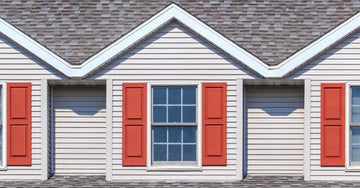Vinyl shutters are often a preferred choice among homeowners who are in the market for exterior shutters. However, it's important to note that vinyl shutters possess certain distinctive qualities that set them apart from other commonly used shutter materials. These characteristics may be considered drawbacks by some customers, leading them to opt for more durable alternatives such as wood, composite, or PVC shutters. These alternative materials offer enhanced durability, resistance to fading, and the ability to withstand extreme weather conditions. As a result, they are often regarded as more reliable options for homeowners seeking long-lasting and robust shutter solutions.


Vinyl shutters are an excellent choice for projects with lower budgets, income properties, or when a fast and convenient alternative is desired. However, it's important to consider certain concerns regarding their durability. Vinyl shutters are more susceptible to cracking and fading, resulting in a shorter lifespan, particularly in areas experiencing extreme weather conditions and direct sunlight. Additionally, improper installation can cause warping and bowing, which can negatively impact the overall curb appeal of a home.
The primary distinction between vinyl and other wood materials lies in the fact that vinyl shutters have a hollow back and cannot be installed as functional shutters like their wooden counterparts. However, the appearance of functionality can be achieved by adding faux hardware to mimic the desired aesthetic.
Below is a more detailed breakdown of the distinctions between material types.
Wood Shutters
Wood shutters offer a classic and natural aesthetic that many people find appealing. They can be made from various types of wood, such as basswood, cedar, or pine. Wood shutters tend to be heavier and may require additional hardware to support their weight. They can be stained or painted to match different interior designs. However, wood shutters typically require more maintenance, such as regular cleaning, repainting, and refinishing. They are also more susceptible to damage from moisture, sunlight, and pests.
Composite Shutters
Composite shutters are constructed using a combination of wood fibers or particles and synthetic materials. They are designed to emulate the appearance of wood while offering enhanced durability and resistance to moisture. Composite shutters are often more expensive than vinyl shutters but can provide a more authentic wood-like look. They generally require less maintenance compared to wood shutters, as they are less prone to warping, cracking, and fading.
PVC Shutters
PVC shutters are made from polyvinyl chloride. They are lightweight, durable, and resistant to moisture, making them an excellent choice for high-humidity areas such as bathrooms and kitchens. PVC shutters are easy to clean and maintain, requiring only occasional wiping with a damp cloth. They are available in a variety of colors and styles. However, some people may find that PVC shutters lack the warmth and authenticity of wood shutters.
Aluminum Shutters
Aluminum shutters are lightweight and can provide security and protection against weather elements. They offer excellent durability, strength, and resistance to rust and corrosion. Aluminum shutters can be both decorative and hurricane grade. However, they may not offer the same aesthetic appeal as wood or composite shutters and are often chosen more for their functionality and practicality.
In conclusion, when deciding between shutter materials it's important to consider factors such as your desired appearance, budget, maintenance requirements, and the specific location where the shutters will be installed. Each material has its own unique characteristics and advantages, so it's best to evaluate your needs and preferences before making a decision. Here is a helpful article on deciding which material suits you best, but please reach out if you have any questions!

